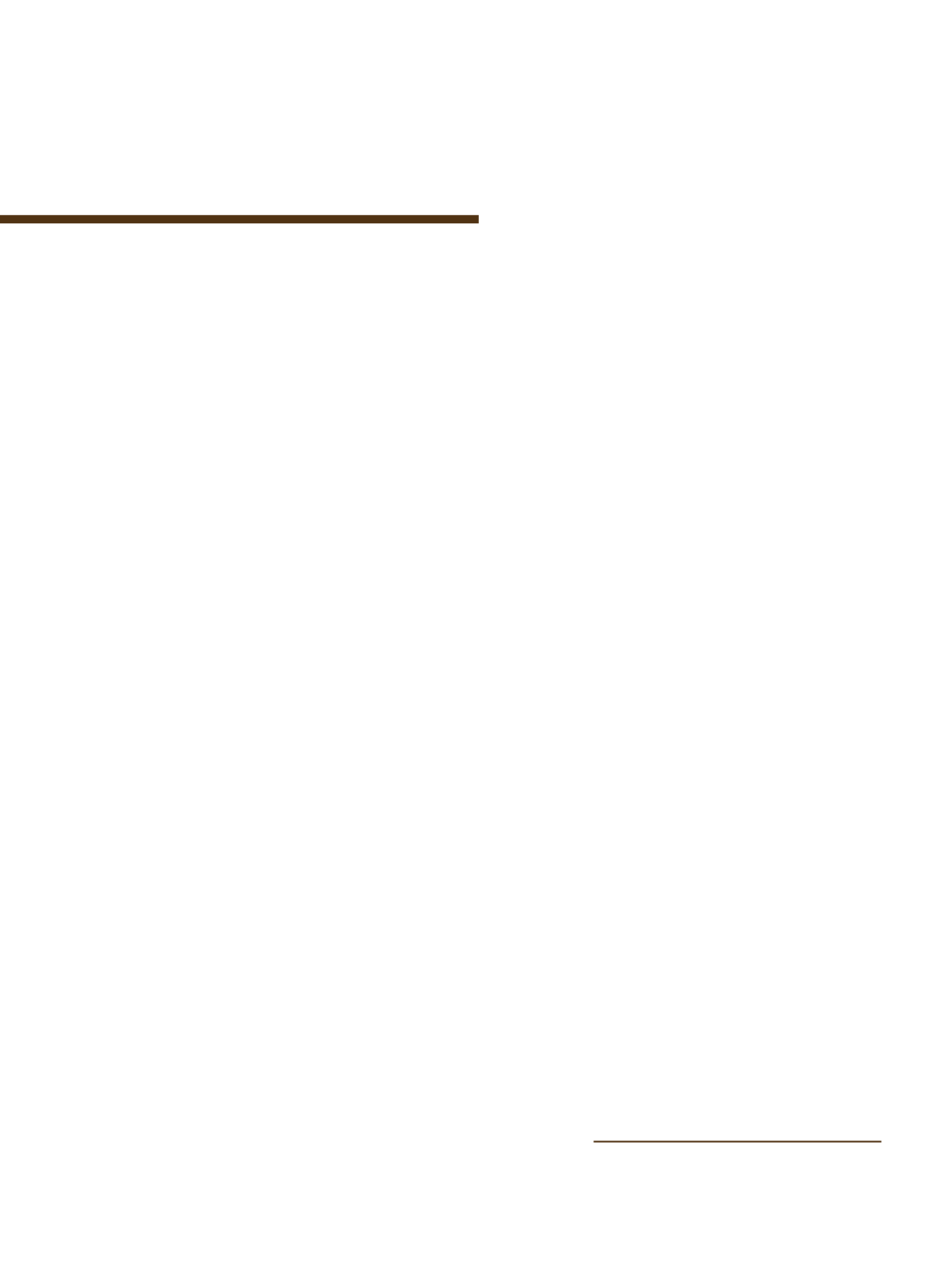
The harvest of 705.93 thousand tons of tobacco in the 2016/17 growing sea-
son generated gross income of R$ 6.09 billion at delivery to the industry. Rev-
enue soared, but the law of supply and demand, which benefited the farmers
because of the crop failure in the 2015/16 crop year, this time had an opposite
effect: with more tobacco available, prices dropped 13.3% on average, includ-
ing the three types cultivated in the South.
Average values remained at R$ 8.63 at the end of the season, taking into con-
sideration R$ 8.77 per kilogram of Virginia, R$ 7.85 per kilogram of Burley and R$
6.09 per kilogram of Comum. Prices fell R$ 1.33 per kilogram, on average, con-
Ashot in the
the arm
Abumper crop in2016/17 brought ingross income of
R$ 6.09 billion, but oversupply adversely affected the
price per kilogramof tobacco paid to the farmers
sidering the three types, compared to R$ 9.96
fetched in the previous crop year, when the cli-
mate phenomenon El Niño was responsible for
a crop of only 525.2 thousand tons.
The technical manager at the Tobacco
Growers’ Association of Brazil (Afubra), Pau-
lo Vicente Ogliari, has it that the favorable cli-
mate made regional production soar. “It was
an excellent crop, which assumes even higher
proportions if compared to the previous year,
when a crop failure occurred.
In the South Region, Flue-Cured Virgin-
ia represented 85.4% of the planted area –
254.95 thousand hectares – and 87.4% of the
volume harvested, 616.7 thousand tons. Bur-
ley occupied an area of 39.940 thousand hect-
ares, or 13.4% of the cultivated area, with a
harvest of 80.4 thousand tons (11.4%). As for
the Comum type, of lower commercial value,
it occupied only 3,640 hectares, equivalent
to 1.2% of the regional area, for a harvest of
8,830 tons (1.25%).
Rio Grande do Sul devoted 145.4 thousand
hectares to tobacco in the season, with 123.5
thousand destined for Virginia, 21.6 thou-
sand to Burley and 260 hectares to Comum,
and harvested 346,380 thousand tons. Flue-
Cured Virginia represented 87% of the crop,
Burley, 12.7%, and Comum, 0.3%. The fields
in Rio Grande do Sul accounted for 49% of the
planted area and 49% of the volume harvest-
ed; Santa Catarina planted 31% of the region-
al fields and harvested 29.3%, that is to say,
206,380 tons. Paraná contributes with 20% of
the land devoted to the crop and with 21.7%
of the volume.
In the 2017/18 growing season, the per-
centage proportions in area (both per State
and type) and production should remain the
same, with occasional alterations in produc-
tivity in some fields in Rio Grande do Sul, be-
cause of excessive precipitation, and in San-
ta Catarina due to Indian summers and dry
spells. The tobacco crop involved a total of
150,240 families in the South. The sector em-
ploys, either directly or indirectly, 2.14 million
people. In 2016, it generated income and tax-
es of around R$ 30 billion.
Law of supply
and demand is again in
force at crop sale
THROUGHOUT THE COUNTRY
The three southern states of Brazil represent 98% of the national tobacco crop,
but we shouldnot look downon the 2%that the activity represents inother regions,
particularly in the Northeast. Production in the Northeast relies on two big hubs:
Recôncavo Baiano, in a region that comprises 23 municipalities, like São Félix and
SãoGonçalo dos Campos, where the highlights are the production of cigars and cig-
arillos; and on the surroundings of Arapiraca, in Alagoas, whose crop is focused on
rope tobacco, or cut tobacco, for homemade strawor silk cigarettes.
The statistical figures of the 2016/17 crop year indicate that seven states in the
Northeast of Brazil cultivated 12.6 thousand hectares and harvested 13.6 thousand
tons of tobacco. The expectation is for the Census of Agriculture, now underway, to
come up withmore precise numbers in light of the estimate usually released by the
Brazilian Institute of Geography and Statistics (IBGE) or by sectoral entities. The bulk
of the production in the Northeast is destined for the domestic market, but Bahia,
despite the tax relatedhurdles for competing in thedomestic and internationalmar-
ket, still exports cigars and cigarillos, cultivating dark tobacco andwrapper leaf.
The challenge in Bahia consists in surmounting the tax barriers – even in the do-
mestic market – and make a come back to the time when the crop was the engine
of regional development and conquered international acclaim for the quality of the
product. One of the current strategies of the sector consists in promoting tourism
associated with the cigar industries, and get the geographical indication label. The
commemorations of theWorldTobaccoGrowers’ Day inOctober 2016were ideal for
giving publicity to the objective the supply chain is fighting for.
In December 2016, the Bahia Tobacco Industry Union (Sinditabaco-BA), took a
fundamental step towards the Geographical Indication registration process and De-
nomination of Origin (DO) when the Bahia-Brazil Geographical Delimitation Term
was signed. The Recôncavo region was acknowledged as a location with exclusive
characteristics for theproductionof cigar tobaccoof goodquality, anddistinguished
flavor, aroma and color. Since 2015 some companies in South Brazil have been con-
ducting experiments on large-scale cultivations –mechanized – in that State.
20


